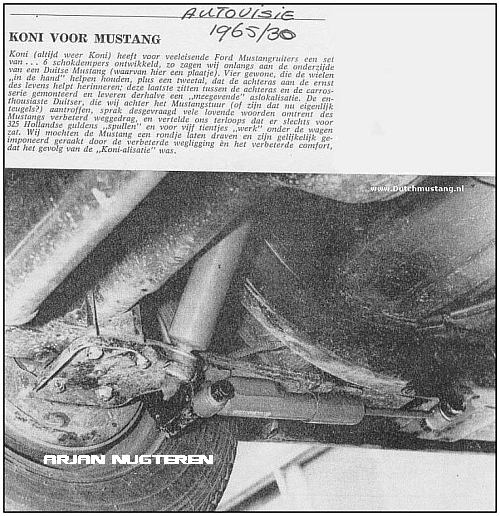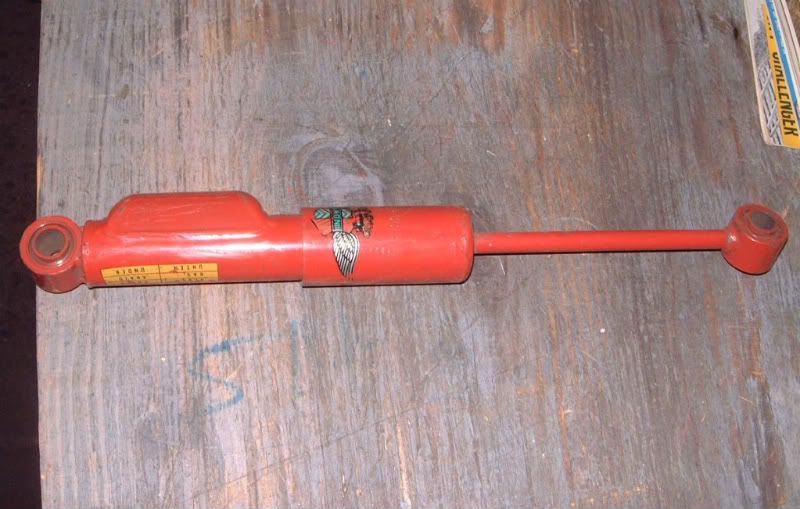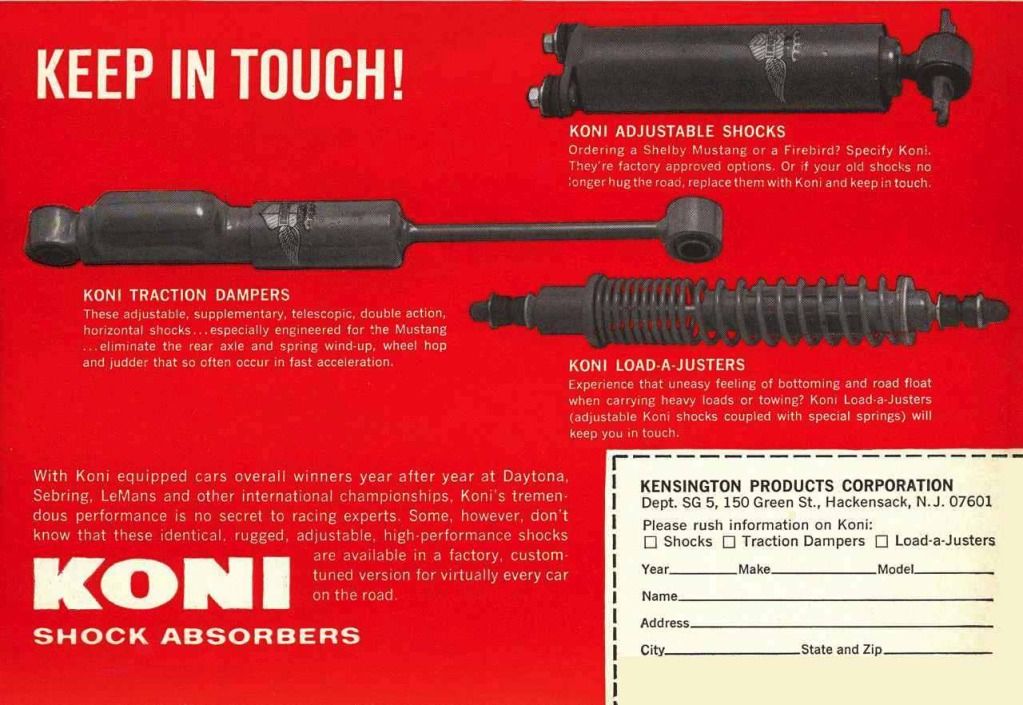The car later became Charlie Kemp's "World's winningest Shelby", extensively described in Alex Gabbard's "Fast Mustangs" book
- Welcome to SAAC Forum.
This section allows you to view all posts made by this member. Note that you can only see posts made in areas you currently have access to.
#2
1965 GT350/R-Model / Re: Anyone ever seen one of these Konis?.... 2-64 dated, C4ZF-18080 stamped....
September 16, 2023, 07:32:27 AMQuote from: TransamEd on August 02, 2023, 01:49:10 AM
If I remember correctly they had a 1964 Mustang shipped over from UK to Koni/Netherlands, I will need to find again, which one it was.
Acc to this article (thanks to Arjan Nugteren/Dutchmustang.nl) Koni developped a variety including a 6 damper upset (2 guide the rear axle better) (Autovisie 30/1965)On sale for 325 dutch guilders.
Interesting info about the rear axle dampers. They're also discussed here: http://www.camaros.org/forum/index.php?topic=7795.15
I thought they were hydraulic replacements for the solid overrider bars but now see in Ed's link that they were intended for below the axle, just like Traction Masters. They would probably not fit anyway in the override position, considering the small slot in the wheel housing they need to fit through.



#3
1965 GT350/R-Model / Re: Anyone ever seen one of these Konis?.... 2-64 dated, C4ZF-18080 stamped....
August 01, 2023, 10:57:19 AM
I realize this thread is kind of old now, but I just noticed these shocks have Oud Beijerland stamped in them, which is the Dutch town where Koni is headquartered. I've never noticed that on Konis before, but I'm no expert on early Konis.
#4
1965 GT350/R-Model / Re: GT 350 Carb?
July 12, 2022, 03:00:09 AM
Speaking of 67 GT350 carbs, did the automatics get the Autolite 4100, like they did in 1966, or did they all get the Holley?
#5
1965 GT350/R-Model / Re: 65 Hipo Engine Balance
March 20, 2022, 03:46:01 PMQuote from: gt350hr on February 24, 2022, 05:43:04 PM
It was to counteract the heavier rods ( big end weight) It was also used on other "non production" engines like the Tunnel Port 302 and Boss 302 T/A engines.
I read that the reason for the hatched was to move some of the counterweight a little more inwards. The increase from 28 oz.inch inbalance to ~30 for the Hipo made the front end counterweight too heavy (too much bending forces) and so a 25 oz.in damper and 5 oz.in hatchet were used instead.
Any truth to that? It sounds logical in one way, but also like a lot of effort for a modest improvement.
#6
1965 GT350/R-Model / Re: 1965 gt350R model Camshaft
March 15, 2022, 07:24:43 AM
One issue with the specs for these old mechanical lifter cams is that you never know how they measured them and what lash they took into account. For the Hipo cam for example, I've seen durations of both 310 and 290 degrees and ~.470" lift (lobe lift x 1.6, probably) and ~.450" lift (actual valve lift)
#7
1965 GT350/R-Model / Re: Another 65 G.T. 350 video recently posted
January 14, 2022, 01:56:40 AMQuote from: FL SAAC on January 09, 2022, 10:08:03 AM
Take aways:
The squid he gave a ride to really enjoyed himself or soiled his pants. I couldn't tell....
Thanks for posting
I doubt he soiled his pants. This is his daily driver: https://www.youtube.com/watch?v=U1HnCeA2ljY
#8
1966 Shelby GT350/GT350H / Re: Quick dissertation on 65/66 Shelbys from Legendary Motorcar
August 17, 2021, 07:51:38 AMQuote from: 2112 on July 25, 2021, 09:36:27 PMQuote from: 427hunter on July 25, 2021, 01:48:02 PM
You can still track your car, they track vintage Ferrari's worth more then twenty times the value of a 65 gt350.
True, but when one of those super valuable F-cars get banged up, does everyone wring their hands and complain that the car no longer has it's "born-with" parts or do they just fix it and move on?
🤔
I sometimes get the impression that for super rare cars, originality becomes less important. With rare cars I mean very low total production of the model.
For special versions of high volume cars, originality of the details is (highly) important, because it's the details that makes it rare. To give a Ford related example: A Mustang K-code coupe is (somewhat) rare, but without the original engine, most of what makes it special is gone and it's just another Mustang. A GT40 on the other hand will always be 1/~100, even after 4 crashes and 10 engine swaps.
#9
1965 GT350/R-Model / Re: Holley 715 CFM #3259 float level adjustment
June 18, 2021, 01:40:48 AM
I have a quick change pot on another carb so I'll probably install that some time and test to find out the best spring. Installing the heavy one was more a matter of let's see what it does.
I agree that the chart is just an approximation with many variables. Or rather, the Holley table is probably accurate for that particular carb on that particular engine and serves as an approximation for other applications.
I agree that the chart is just an approximation with many variables. Or rather, the Holley table is probably accurate for that particular carb on that particular engine and serves as an approximation for other applications.
#10
1965 GT350/R-Model / Re: Holley 715 CFM #3259 float level adjustment
June 16, 2021, 04:28:04 PM
I didn't check it, but it's a regular 289 fuel pump. I did rev it up to max with the sight plugs off to see if fuel level rose abnormally but it stayed were it was so I called it good.
I had a look at Holley's chart for secondary springs which listed the start of opening and fully open engine speeds for a 350 and a 402 with a 3310 (750 cfm) carburetor. The different values scaled almost perfectly with the difference in displacement between the two, so I recalculated them for a 289, also taking into account that secondaries are a little larger and thus flow a little more. The results are in the chart. For the black spring it actually said that it didn't fully open so I had to make a guess here for the "fully open RPM".
As I wrote yesterday, manifold vacuum was just about to creep up (an inch Hg or so) at 6000 RPM with the black spring installed. The theoretical air consumption of a 289 at 6000 RPM is ~500 cfm, which matches the chart almost perfectly. Maybe dumb luck, because I made several assumptions, but still fun to see.
I had a look at Holley's chart for secondary springs which listed the start of opening and fully open engine speeds for a 350 and a 402 with a 3310 (750 cfm) carburetor. The different values scaled almost perfectly with the difference in displacement between the two, so I recalculated them for a 289, also taking into account that secondaries are a little larger and thus flow a little more. The results are in the chart. For the black spring it actually said that it didn't fully open so I had to make a guess here for the "fully open RPM".
As I wrote yesterday, manifold vacuum was just about to creep up (an inch Hg or so) at 6000 RPM with the black spring installed. The theoretical air consumption of a 289 at 6000 RPM is ~500 cfm, which matches the chart almost perfectly. Maybe dumb luck, because I made several assumptions, but still fun to see.
#11
1965 GT350/R-Model / Re: Holley 715 CFM #3259 float level adjustment
June 16, 2021, 01:00:29 AM
Mine are now at the equivalent of .0323 but still a little rich, at least for my engine. On an actual GT350 it may be different.
I wonder why they made those idle feed restrictors so large? I understand that they already did that during the 60's?
Do you know if they increased the secondary idle feed as well?
I wonder why they made those idle feed restrictors so large? I understand that they already did that during the 60's?
Do you know if they increased the secondary idle feed as well?
#12
1965 GT350/R-Model / Re: Holley 715 CFM #3259 float level adjustment
June 15, 2021, 05:45:40 PM
Well, after a long break I finally got back at tuning the Holley. Last year I already installed some bowl sight plugs and had adjusted the float levels a bit below the bottom of the hole (which is the normal rule of thumb setting). But that didn't make any difference.
This time, I took Drew's advice and popped out the idle well plugs. Everything was nice and clean in there, but these carbs have the idle feed restrictors hidden in this well. Measuring their size with a 1 mm drill showed that they were probably ~0.041". I had no idea if that was big or small, but some googling showed that a normal size for a ~750 cfm Holley is in the low .030 range. In combination with my mild roller cam (and thus extra high vacuum), this was probably the reason for the rich transition circuit.
I stuck in some small wires and made some new caps out of aluminum (I didn't have any brass ones). That leaned out the transition circuit somewhat from 10 to 11.5 and thus not nearly enough. At cruising speeds, the AFR creep up somewhat but dropped back to 12 right away due to the power valve. Looking at the vacuum gauge during driving, I concluded that the 8,5" power valve kicked in way too soon. I then installed a 6,5" PV which allowed the AFR creep up to 14, but the power valve still kicked in too soon, especially in fifth gear.
I took it apart again, inserted a thicker wire in the idle feed restriction (0.024", reducing the flow area by 1/3th) and at the same time, I also installed #66 jets (instead of the stock #68), a 3.5" power valve and the stiffest (black) spring in the secondary canister (it had the next to lightest yellow one, which I assume is what it came with). Not very scientific perhaps to make so many changes at the same time, but I had grown tired of taking the carb apart all the time.
Anyway, idle AFR remained at ~13, light cruise (on the transfer circuit) increased the AFR to ~13, cruise (on the main jets) to 14.5-15 and WOT to ~13. It smelled much less and drove smoothly without much hesitation. There's still some under some conditions, so a little more tuning of the acceleration circuit required I guess, but overall it drives well. At 6000 RPM, manifold vacuum crept up to maybe 1" Hg (hard to see exactly when trying to look at the tach, the vacuum gauge and of course the road at the same time...), so I guess the stiff secondary spring didn't make the carb very restrictive. The light cruise AFR didn't increase as much as the flow area reduction suggested but I guess that's due to the unchanged secondary idle circuit. Maybe I'll give it one more go and fix that too.
This time, I took Drew's advice and popped out the idle well plugs. Everything was nice and clean in there, but these carbs have the idle feed restrictors hidden in this well. Measuring their size with a 1 mm drill showed that they were probably ~0.041". I had no idea if that was big or small, but some googling showed that a normal size for a ~750 cfm Holley is in the low .030 range. In combination with my mild roller cam (and thus extra high vacuum), this was probably the reason for the rich transition circuit.
I stuck in some small wires and made some new caps out of aluminum (I didn't have any brass ones). That leaned out the transition circuit somewhat from 10 to 11.5 and thus not nearly enough. At cruising speeds, the AFR creep up somewhat but dropped back to 12 right away due to the power valve. Looking at the vacuum gauge during driving, I concluded that the 8,5" power valve kicked in way too soon. I then installed a 6,5" PV which allowed the AFR creep up to 14, but the power valve still kicked in too soon, especially in fifth gear.
I took it apart again, inserted a thicker wire in the idle feed restriction (0.024", reducing the flow area by 1/3th) and at the same time, I also installed #66 jets (instead of the stock #68), a 3.5" power valve and the stiffest (black) spring in the secondary canister (it had the next to lightest yellow one, which I assume is what it came with). Not very scientific perhaps to make so many changes at the same time, but I had grown tired of taking the carb apart all the time.
Anyway, idle AFR remained at ~13, light cruise (on the transfer circuit) increased the AFR to ~13, cruise (on the main jets) to 14.5-15 and WOT to ~13. It smelled much less and drove smoothly without much hesitation. There's still some under some conditions, so a little more tuning of the acceleration circuit required I guess, but overall it drives well. At 6000 RPM, manifold vacuum crept up to maybe 1" Hg (hard to see exactly when trying to look at the tach, the vacuum gauge and of course the road at the same time...), so I guess the stiff secondary spring didn't make the carb very restrictive. The light cruise AFR didn't increase as much as the flow area reduction suggested but I guess that's due to the unchanged secondary idle circuit. Maybe I'll give it one more go and fix that too.
#13
Replicas and Tribute / Re: 65 Mustang steering box
June 15, 2021, 07:14:32 AM
Late answer, but yes: it's a matched set. It's basically a fancy version of a bolt (shaft) and a nut (block) and just as the thread pitch of a bolt and a nut must match, so do these steering parts.
#14
Replicas and Tribute / Re: 65 Mustang steering box
May 23, 2021, 03:54:15 PM
The difference between the 16:1 and 19:1 ratio boxes is in the worm gear. It's a matched set of shaft and block as the balls recirculate through the block back to the other end of the shaft and as a consequence the pitch of shaft and block needs to be the same. I never counted the grooves but the quicker ratio must have fewer per inch. I believe 19:1 is a rounded number and that ratio is actually 19+:1, so 8 for the quick box and 10 for the slow one makes sense.
#15
1965 GT350/R-Model / Re: 5 S 114 - the Journey in Europe - 6 / 65 Modena Test - 35 negativ Film Pics
May 23, 2021, 01:53:44 PMQuote from: Szabo on December 04, 2020, 05:12:57 PM
the last magazine i know was
Autovisie 1965
this was from Netherland in dutch language
the car stands on gras, but when you look on the first test, you see that is clearly the same car and test...
I think this article was also posted a few years ago (and got lost when there were forum issues I think). I posted a translation back then (I'm dutch). I'll check if I still have it somewhere.
